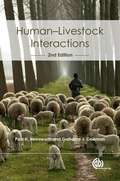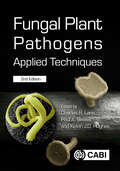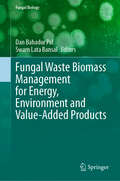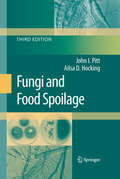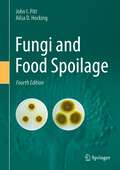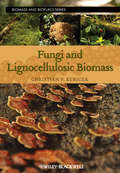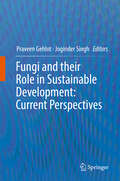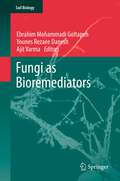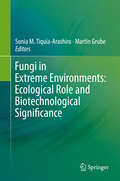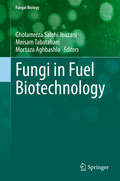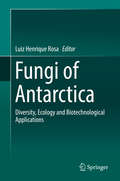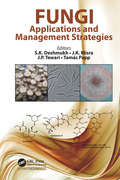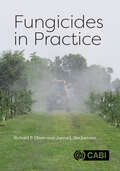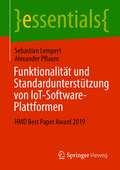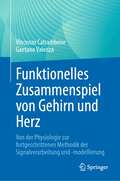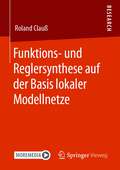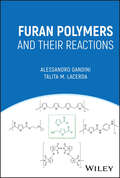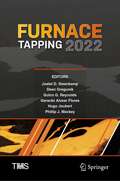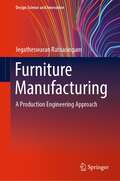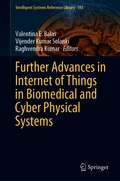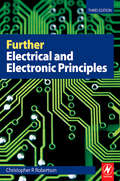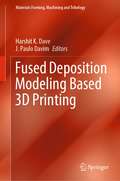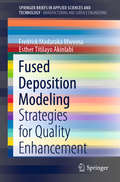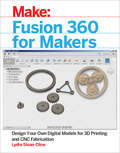- Table View
- List View
Fungal Plant Pathogens
by Charles Lane David Cooke Kelvin Hughes Jenny Tomlinson David Galsworthy Christopher Thornton Belinda Phillipson Paul Beales Matthew RyanCovering the key techniques used when working with fungal plant pathogens, this practical manual deals with recognition of disease symptoms, detection and identification of fungi and methods to characterise them well as curation, quarantine and quality assurance. The book is unique in its practical focus, providing an overview of both traditional and emerging methods and their applications, and detailed protocols on completion techniques such as microscopy, PCR, ELISA, freeze drying and DNA storage. Fungal Plant Pathogens provides a valuable guide to investigating fungal plant diseases and interpreting laboratory findings for postgraduate and advanced undergraduate students, extension plant pathologists, consultants and advisers in agriculture and horticulture and the food supply chain.
Fungal Plant Pathogens: Applied Techniques
by Paul Kirk David Smith David Cooke Jenny Tomlinson David Galsworthy Christopher Thornton Belinda Phillipson Michael Long Rachel Barker Matthew J Ryan Kinda Alraiss Victoria Barton Lucy Carson-Taylor Ashleigh Elliot Steve Hendry Anthony Kermode Aiga Ozolina Ana Pérez-Sierra Joan WebberThis substantially updated edition now in full colour provides key techniques used when working with fungal and fungal-like plant pathogens. As a practical manual it also deals with disease recognition, detection and identification of fungi, plus methods to characterise and curate fungi and handle them under quarantine and quality assurance systems. Furthermore, this new edition includes significant updates with respect to: - Greater awareness and concern internationally about plant health and biosecurity. - Molecular biology - next generation sequencing and in-field detection. - Improved opportunities for surveillance and detection in diverse substrates. - Changes in taxonomy and reference to current fungal plant pathogens. - New chapters on tree health, and public awareness, outreach and communications. Fungal Plant Pathogens: Applied Techniques, 2nd edition provides a valuable guide to investigating fungal plant diseases and interpreting laboratory findings for postgraduate and advanced undergraduate students, extension plant pathologists, consultants and advisers in agriculture, forestry and horticulture, and the food supply chain.
Fungal Waste Biomass Management for Energy, Environment and Value-Added Products (Fungal Biology)
by Dan Bahadur Pal Swarn Lata BansalBioconversion of waste is a natural process aiding in the recovery of resources and biotechnology-facilitated natural recycling processes. Biotechnological treatments to food processing wastes found in large quantities can produce useful end products, such as microbial biomass protein, while wastes are also purified during the process. Fungi as microorganism and as fungal biomass have been used for many applications such as enzyme production for biomedical, biorefinery, and other industries. Additionally, environmental pollution is a crucial problem for the entire world, and it is growing continuously. Continuous growth of pollution is resulting harmful changes like global warming and pollution of air, water, and soil. These changes are directly associated with various activities like uncontrolled agricultural practices, deforestation, urbanization, accumulation of huge amounts of agricultural and food waste, improper dumping of naturally occurred waste and forest residues, etc. Therefore, proper utilization of these wastes may be a better solution for this problem. Fungal-based biomass materials are good sources of carbohydrates, oil & fats, cellulosic content, and other useful chemical components which can be converted into value-added products for production of clean energy, bioenergy, bio-adsorbents, and useful chemicals. This book provides information, processes, and ideas for the conversion of waste into useful and consumable enzymes through biological approaches. Within the last few years, researchers have found that food and agricultural waste biomass have the potential to produce value-added products. Technological information for the production of nutraceuticals and organic acids from the agro-waste are also covered in this book.
Fungi and Food Spoilage
by John I. Pitt Ailsa D. HockingThis is the third edition of the definitive work on fungi in foods covering identification, isolation, enumeration, taxonomy, physiology and mycotoxin formation. High quality halftones provide a book of great value to food microbiologists, mycologists, food scientists and technologists and all those involved in food quality and safety.
Fungi and Food Spoilage
by John I. Pitt Ailsa D. HockingThe first three editions of Fungi and Food Spoilage established, then consolidated, a reputation as the leading book on foodborne fungi. It details media and methods for isolation and identification, descriptions of species, and information on their physiology, ecology and mycotoxin formation. It is an invaluable reference for food microbiologists investigating fungal food spoilage problems, both in field crops and processed foods, and the likelihood of mycotoxin production in either.The Fourth Edition incorporates major differences from the Third: multiple changes in nomenclature due to changes in the International Code of Nomenclature for algae, fungi and plants; many taxonomic changes due to improvements in, and more widespread application of, molecular methods in taxonomy; the introduction of colour colony photographs where appropriate; and a new chapter on mycotoxins.The introductory chapters of the book deal with the ecology of food spoilage, and provide an overview of how food processing, packaging and storage parameters influence fungal growth. A subsequent chapter overviews the fundamentals of naming and classifying fungi. Morphological methods and media suitable for low cost and effective isolation, enumeration and identification of foodborne fungi are provided, together with many more specialised media and techniques. The major part of the book provides keys, descriptions and illustrations of all yeasts and filamentous fungi commonly encountered in foods. Other known characteristics of the species, including physiology and ecology are included. Chapters on the types and species of fungi likely to be found in fresh, harvested and variously processed foods are followed by a new chapter on mycotoxins, both major and minor, their sources, both fungal and food, and their implications for human health.The broad and practical nature of the coverage will appeal to microbiologists, mycologists and biotechnologists in the food industry, as well scientists in academic, research and public health institutions.Drs Pitt and Hocking worked for CSIRO Food for more than 100 years combined. Both are now retired from CSIRO: Dr Pitt continues to work part time with Microbial Screening Technologies, a biodiscovery company.
Fungi and Lignocellulosic Biomass
by Christian P. KubicekHarnessing fungi's enzymatic ability to break down lignocellulolytic biomass to produce ethanol more efficiently and cost-effectively has become a significant research and industrial interest. Fungi and Lignocellulosic Biomass provides readers with a broad range of information on the uses and untapped potential of fungi in the production of bio-based fuels.With information on the molecular biological and genomic aspects of fungal degradation of plant cell walls to the industrial production and application of key fungal enzymes, chapters in the book cover topics such as enzymology of cellulose, hemicelluloses, and lignin degradation. Edited by a leading researcher in the field, Fungi and Lignocellulosic Biomass will be a valuable tool in advancing the development and production of biofuels and a comprehensive resource for fungal biologists, enzymologists, protein chemists, biofuels chemical engineers, and other research and industry professionals in the field of biomass research.
Fungi and their Role in Sustainable Development: Current Perspectives
by Praveen Gehlot Joginder SinghThis book illustrates the multiple roles of fungi in everyday life. Fungi are the large group of organisms with tremendous diversity and economic importance. Their ability to produce commercially efficient useful products makes them the vulnerable sustainable tool for the future generation. This book describes a systems approach and provides a means to share the latest developments and advances about the benefits of fungi including their wide application, traditional uses, modern practices, along with designing of strategies to harness their potential. The chapters are organized with data, providing information related to different sustainable aspects of fungi in agriculture, its cultivation and conservation strategies, industrial and environmental utilization, advanced bioconversion technologies and modern biotechnological interventions. Updated information and current opinion related to its application for sustainable agriculture, environment, and industries as futuristic tools have been presented and discussed in different chapters. The book also elucidates a comprehensive yet a representative description of the challenges associated with the sustained application of fungi to achieve the goals of sustainability.
Fungi as Bioremediators
by Ajit Varma Ebrahim Mohammadi Goltapeh Younes Rezaee DaneshBiological remediation methods have been successfully used to treat polluted soils. While bacteria have produced good results in bioremediation for quite some time now, the use of fungi to decontaminate soils has only recently been established. This volume of Soil Biology discusses the potentials of filamentous fungi in bioremediation. Fungi suitable for degradation, as well as genetically modified organisms, their biochemistry, enzymology, and practical applications are described. Chapters include topics such as pesticide removal, fungal wood decay processes, remediation of soils contaminated with heavy and radioactive metals, of paper and cardboard industrial wastes, and of petroleum pollutants.
Fungi in Extreme Environments: Ecological Role and Biotechnological Significance
by Martin Grube Sonia M. Tiquia–ArashiroOver the last decades, scientists have been intrigued by the fascinating organisms that inhabit extreme environments. These organisms, known as extremophiles, thrive in habitats which for other terrestrial life-forms are intolerably hostile or even lethal. Based on such technological advances, the study of extremophiles has provided, over the last few years, ground-breaking discoveries that challenge the paradigms of modern biology. In the new bioeconomy, fungi in general, play a very important role in addressing major global challenges, being instrumental for improved resource efficiency, making renewable substitutes for products from fossil resources, upgrading waste streams to valuable food and feed ingredients, counteracting life-style diseases and antibiotic resistance through strengthening the gut biota, making crop plants more robust to survive climate change conditions, and functioning as host organisms for production of new biological drugs. This range of new uses of fungi all stand on the shoulders of the efforts of mycologists over generations. The book is organized in five parts: (I) Biodiversity, Ecology, Genetics and Physiology of Extremophilic Fungi, (II) Biosynthesis of Novel Biomolecules and Extremozymes (III) Bioenergy and Biofuel synthesis, and (IV) Wastewater and biosolids treatment, and (V) Bioremediation.
Fungi in Fuel Biotechnology (Fungal Biology)
by Meisam Tabatabaei Mortaza Aghbashlo Gholamreza Salehi JouzaniDue to the huge quantity and diverse nature of their metabolic pathways, fungi have great potential to be used for the production of different biofuels such as bioethanol, biobutanol, and biodiesel. This book presents recent advances, as well as challenges and promises, of fungal applications in biofuel production, subsequently discussing plant pathogenic fungi for bioethanol and biodiesel production, including their mechanisms of action. Additionally, this book reviews biofuel production using plant endophytic fungi, wood-rotting fungi, fungal biocontrol agents, and gut fungi, and it investigates highly efficient fungi for biofuel production and process design in fungal-based biofuel production systems. Finally, life cycle assessment of fungal-based biofuel production systems are discussed in this volume.
Fungi of Antarctica: Diversity, Ecology and Biotechnological Applications
by Luiz Henrique RosaThis book focuses on the fungi found in one of the most pristine regions on Earth: Antarctica. It discusses the fungal occurrence in all substrates of the region, including soil, seawater, lake and marine sediments, rocks, ice, and snow. It also addresses the impact of climate changes on these organisms, the genomic techniques developed to study them, and how a number of compounds, such as antibiotics and enzymes, produced by the Antarctic fungi can be used in medicine, agriculture and the chemical industry.
Fungi: Applications and Management Strategies (Progress in Mycological Research #3)
by Sunil K. Deshmukh J. K. Misra Jalpa P. Tewari Tamas PappThe book deals with the application of fungi and the strategic management of some plant pathogens. It covers fungal bioactive metabolites, with emphasis on those secondary metabolites that are produced by various endophytes, their pharmaceutical and agricultural uses, regulation of the metabolites, mycotoxins, nutritional value of mushrooms, prospecting of thermophilic and wood-rotting fungi, and fungi as myconano factories. Strategies for the management of some plant pathogenic fungi of rice and soybean have also been dealt with. Updated information for all these aspects has been presented and discussed in different chapters.
Fungicides in Crop Protection
by Richard Oliver H HewittPlant pathogenic fungi cause devastating damage to crop production worldwide. The growing global population necessitates reduced crop losses to improve food security, and the control of fungal plant pathogens is vital to help maintain food production. Providing a concise and balanced review of fungicides used in crop protection, this book describes the science of fungicide use, selection and resistance within the context of farming situations. Major updates and additions reflecting the emergence of two new classes of fungicides (strobilurins and SDHI) and the increased incidence of fungicide resistance are included in this new edition, which also discusses legislative requirements to reduce fungicide applications, and current trends in fungicide use.
Fungicides in Practice
by Richard P. Oliver Professor Janna L BeckermanThis is an up-to-date guide on the science and practice of disease control based on fungicides in horticulture and broad acre agriculture. It describes how conventional, organic and biological fungicides are discovered, how they work and how resistance evolves. Chapters on formulation, mode of action, mobility and application inform decisions about which fungicides to use, when to use them, and how to rotate (or tank-mix) them, to manage both plant disease and fungicide resistance. A chapter on experimental design of fungicide trials aids practitioners in designing their own trials to evaluate how effective products are for their plant disease problem. Based on the successful 2014 book of Fungicides in Crop Protection this edition has four entirely new chapters, and extensive updates to the other nine chapters. The contents include: · Fungicide markets, discovery and performance. · Modes of action and spectrum. · Biological crop protection, and organic cultivation. · Fungicide formulation, mobility and application. · Experimental design of fungicide trials and their analysis. · Fungicide resistance. · Legislation and regulation. Written for crop protection professionals and scientists, growers, agronomists and consultants, the book is also suitable for students of agriculture and agronomy.
Funktionalität und Standardunterstützung von IoT-Software-Plattformen: HMD Best Paper Award 2019 (essentials)
by Alexander Pflaum Sebastian LempertDerzeit konkurrieren über 450 Anbieter von IoT-Software-Plattformen miteinander, die Komplexität und die unterschiedlichen Eigenschaften dieser Plattformen führen zu einem intransparenten Markt. Folglich stehen Unternehmen, die eine IoT-Anwendung unter Weiternutzung ihrer bestehenden IT-Infrastruktur umsetzen wollen, vor der Herausforderung, die für diesen unternehmensspezifischen Anwendungsfall am besten geeignete IoT-Plattform aus einer Vielzahl von Kandidaten auszuwählen. Vor diesem Hintergrund werden Unternehmen durch das vorliegende Buch in die Lage versetzt, die Funktionalität und Standardunterstützung der am Markt verfügbaren IoT-Plattformen schnell zu verstehen und untereinander zu vergleichen.
Funktionelles Zusammenspiel von Gehirn und Herz: Von der Physiologie zur fortgeschrittenen Methodik der Signalverarbeitung und -modellierung
by Gaetano Valenza Vincenzo CatramboneDiese Monographie bietet einen systemübergreifenden Austausch und eine modalitätsübergreifende Untersuchung des Zusammenspiels von Gehirn und Herz. Das Zusammenspiel von Gehirn und Herz (Brain-Heart Interplay, BHI) ist ein hochgradig interdisziplinäres wissenschaftliches Thema, das sich von der Physiologie des zentralen/autonomen Nervensystems, insbesondere des zentral-autonomen Netzwerks, bis hin zu fortgeschrittener Signalverarbeitung und Modellierung zur Quantifizierung seiner Aktivität erstreckt. Motiviert durch klinische Befunde und unterstützt durch die neuesten Erkenntnisse der Neurophysiologie, untersucht diese Monographie zunächst die Definition grundlegender Quantifizierer des Zusammenspiels von Gehirn und Herz und geht dann zu fortgeschrittenen Methoden für die Bewertung von Gesundheits- und Krankheitszuständen über. Der nicht-invasive Einsatz von Techniken zur Überwachung des Gehirns, einschließlich des Elektroenzephalogramms und der funktionellen Magnetresonanztomographie, wird zusammen mit der Überwachung der Herzschlagdynamik durch Pulsoximeter und EKG-Signale beschrieben.Das Buch richtet sich insbesondere an biomedizinische Ingenieure und Mediziner mit Fachkenntnissen in Statistik und/oder Signalverarbeitung. Aber auch Forscher in den Bereichen Kardiologie, Neurologie, Psychiatrie und Neurowissenschaften im Allgemeinen können sich für dieses Buch interessieren.
Funktions- und Reglersynthese auf der Basis lokaler Modellnetze
by Roland ClaußDer Autor untersucht eine Methode zur Realisierung modellbasierter Funktionsentwicklung im industriellen Umfeld und der damit einhergehenden zeitlichen Ristrektionen eines Entwicklungsprojekts. Der Schwerpunkt liegt dabei auf der Systemidentifikation (datenbasierten Modellbildung) statischer oder dynamischer nichtlinearer Systeme, die auf der Basis lokaler Modellnetze realisiert wird. Für die Strukturoptimierung der Modellnetze werden zwei neue Ansätze vorgestellt, die eine hohe Effizienz und Genauigkeit bei der Modellbildung aufweisen. Der Autor integriert im nächsten Schritt die identifizierten Modelle in verschiedene beschränkte prädiktive Mehrgrößenregler eines Wärmepumpensystems und zeigt eine Strategie auf, um das System im geschlossenen Regelkreis effizient auszulegen und zu validieren.
Furan Polymers and their Reactions
by Alessandro Gandini Talita M. LacerdaFURAN POLYMERS AND THEIR REACTIONS Understand furan polymers and their roles in industrial production Furans are platform chemicals from biomass which have a range of functions in the production of solvents, biofuels, and monomers for industrial polymer synthesis. As the search for sustainable industrial processes makes biomass resources ever more vital, a more detailed understanding of these compounds and their industrial uses has never been more critical. Furan Polymers and their Reactions surveys these crucial compounds and their contributions to polymer synthesis. It discusses the biorefinery of furans, identifies furfural and 5-hydroxymethyl furfural as the key furan monomer precursors for different polymer synthetic processes, and analyzes all the major reactions furans undergo during these processes and the structures, properties and applications of the ensuing materials. The results are a vital contribution to the growing field of renewable industry. Furan Polymers and their Reactions readers will also find: Detailed analysis of key polymerization reactions such as the Diels-Adler reaction, chain-growth and step-growth polymerizations, as well as the chemical modifications of some of these polymers. An authorial team with decades of combined experience in furan chemistry and polymer synthesis Furan Polymers and their Reactions is an essential resource for researchers and professionals in industrial engineering, polymer science, and biotechnology, as well as for any industry professionals working with platform chemicals or polymer synthesis.
Furnace Tapping 2022 (The Minerals, Metals & Materials Series)
by Dean Gregurek Joalet D. Steenkamp Quinn G. Reynolds Gerardo Alvear Flores Hugo Joubert Phillip J. MackeyNo pyrometallurgical smelter can operate without some form of tapping system. It is the one thing all smelters have in common. This collection discusses this meeting point of the science, technology, and skill involved in this process. The tap-hole design process includes a set of design criteria, which need to be revised as the results of laboratory, computational fluid dynamics (CFD), and time-and-motion studies become available. The tap-hole life cycle is considered in this volume, with authors addressing the requirements for installation and operability as well as for maintenance. Matters such as online monitoring of the tap-hole wear, handling of liquid products, and extraction of fumes are all discussed. Although much has been done to make the tapping process as automatic as possible, tapping of smelters cannot be done without labor. Tap floor operators work in harsh environments where safety is of utmost importance. Selection of suitable personnel and intensive training is required and is discussed in this collection.
Furniture Manufacturing: A Production Engineering Approach (Design Science and Innovation)
by Jegatheswaran RatnasingamThis volume covers all aspects of furniture manufacturing from a production engineering perspective. It takes a step-by-step pedagogical approach, dwelling on details which must be understood at every process, as the furniture makes its way through the factory shop floor. The content highlights the global industry, and discusses furniture design and manufacturing systems. The chapters also discuss every stage of the manufacturing process until the finished product is packaged. There is also emphasis on strength design of furniture, furniture testing, environmental compliance, and automation. The contents also discuss the optimization of furniture manufacturing through a mathematical approach and highlights the current global trends impacting the furniture manufacturing industry, especially the circular economy and Industry 4.0. This volume will a useful resource to those in academia and industry.^
Further Advances in Internet of Things in Biomedical and Cyber Physical Systems (Intelligent Systems Reference Library #193)
by Raghvendra Kumar Valentina E. Balas Vijender Kumar SolankiThis book covers the further advances in the field of the Internet of things, biomedical engineering and cyber physical system with recent applications. It is covering the various real-time, offline applications, and case studies in the field of recent technologies and case studies of the Internet of things, biomedical engineering and cyber physical system with recent technology trends. In the twenty-first century, the automation and management of data are vital, in that, the role of the Internet of things proving the potential support. The book is consisting the excellent work of researchers and academician who are working in the domain of emerging technologies, e.g., Internet of things, biomedical engineering and cyber physical system. The chapters cover the major achievements by solving and suggesting many unsolved problems, which am sure to be going to prove a strong support in industries towards automation goal using of the Internet of things, biomedical engineering and cyber physical system.
Further Electrical and Electronic Principles
by C R RobertsonFurther Electrical and Electronic Principles is a core text for pre-degree courses in electrical and electronic engineering courses. The coverage of this new edition has been brought in line with the specialist unit 'Further Electrical Principles' of the 2007 BTEC National Engineering specification from Edexcel. As the book follows a logical topic progression rather than a particular syllabus, it is also suitable for other Level 3 students on vocational courses such as Vocational AS/A Level, City & Guilds courses and NVQs.More advanced material has also been included, making this text also suitable for HNC/HND and foundation degree courses.Each chapter starts with learning outcomes tied to the syllabus. All theory is explained in detail and backed up with numerous worked examples. Students can test their understanding with end of chapter assignment questions for which answers are provided. The book also includes suggested practical assignments and handy summaries of equations. In this new edition, the layout has been improved and colour has been added to make the book more accessible for students.The textbook is supported with a free companion website featuring supplementary worked examples and additional chapters.http://books.elsevier.com/companions/9780750687478
Fused Deposition Modeling Based 3D Printing (Materials Forming, Machining and Tribology)
by J. Paulo Davim Harshit K. DaveThis book covers 3D printing activities by fused deposition modeling process. The two introductory chapters discuss the principle, types of machines and raw materials, process parameters, defects, design variations and simulation methods. Six chapters are devoted to experimental work related to process improvement, mechanical testing and characterization of the process, followed by three chapters on post-processing of 3D printed components and two chapters addressing sustainability concerns. Seven chapters discuss various applications including composites, external medical devices, drug delivery system, orthotic inserts, watertight components and 4D printing using FDM process. Finally, six chapters are dedicated to the study on modeling and optimization of FDM process using computational models, evolutionary algorithms, machine learning, metaheuristic approaches and optimization of layout and tool path.
Fused Deposition Modeling: Strategies for Quality Enhancement (SpringerBriefs in Applied Sciences and Technology)
by Esther Titilayo Akinlabi Fredrick Madaraka MwemaIn this book, fused deposition modeling (FDM) is described with focus on product quality control and enhancement. The book begins by introducing the basics of FDM and its associated process parameters. Then, strategies for quality control and enhancement are described using case studies of both original results by the authors and from published literature. Resolution and print orientation, multi-objective optimizations and surface engineering are identified and discussed as the strategies for enhancing the quality of FDM products in this book.
Fusion 360 for Makers: Design Your Own Digital Models for 3D Printing and CNC Fabrication
by Lydia Sloan ClineLearn how to use Autodesk Fusion 360 to digitally model your own original projects for a 3D printer or a CNC device. Fusion 360 software lets you design, analyze, and print your ideas. Free to students and small businesses alike, it offers solid, surface, organic, direct, and parametric modeling capabilities.Fusion 360 for Makers is written for beginners to 3D modeling software by an experienced teacher. It will get you up and running quickly with the goal of creating models for 3D printing and CNC fabrication.Inside Fusion 360 for Makers, you'll find:Eight easy-to-understand tutorials that provide a solid foundation in Fusion 360 fundamentalsDIY projects that are explained with step-by-step instructions and color photosProjects that have been real-world tested, covering the most common problems and solutionsStand-alone projects, allowing you to skip to ones of interest without having to work through all the preceding projects firstDesign from scratch or edit downloaded designs. Fusion 360 is an appropriate tool for beginners and experienced makers.
